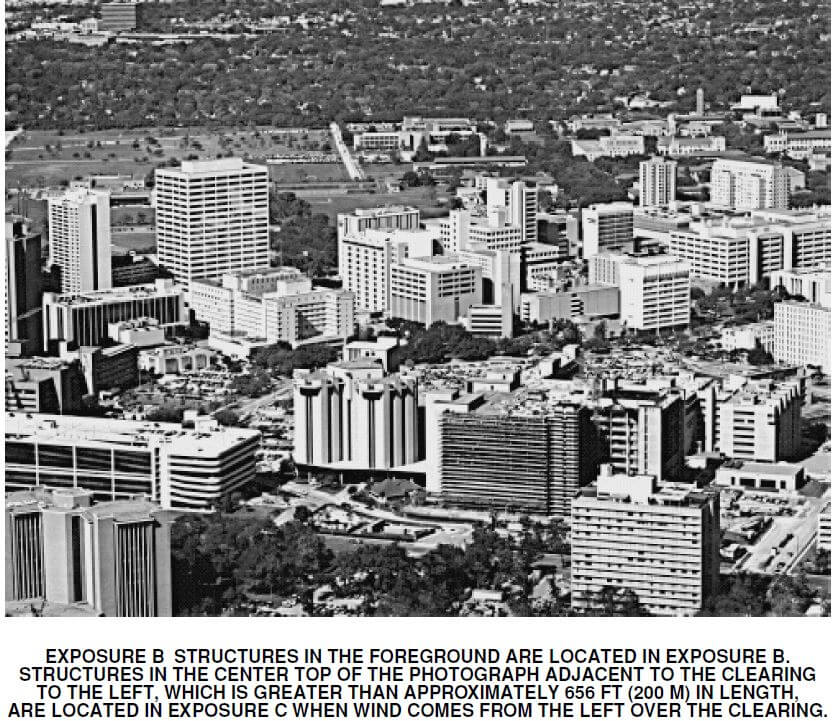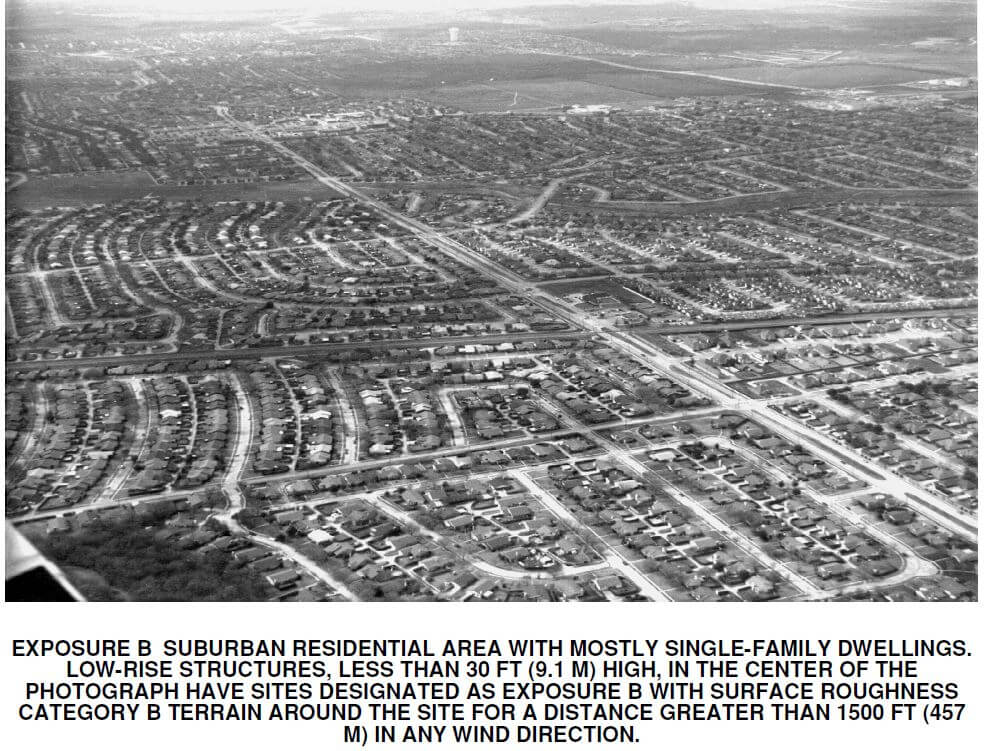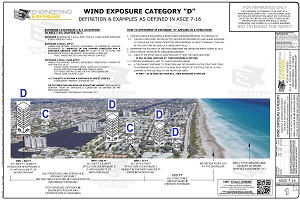Wind Exposure Category Overview
ASCE-7 is the governing referenced standard for design loads on buildings & other structures for building codes throughout the US. ASCE 7 (26.7 of ASCE 7-16) describes the process to which wind speed is converted into wind pressure to design such structures. The formula is based on many variables. One of which is called ‘Exposure Category’ and reflects the characteristics of ground surface irregularities at a site which the building or structure is to be constructed. The rougher the surface, the lower the multiplier that converts wind speed to pressure.
Click here to learn more about the conversion of wind speed to pressure.
Watch as company founder Frank Bennardo PE explains the uses of Exposure Categories
& where they apply, including Exposure D.
About Exposure D & ASCE 7
Exposure ‘D’ is the largest multiplier when converting wind velocity to wind pressure, representing coastal areas and the ‘smoothness’ of water relative to wind.
Non-coastal areas have Exposure categories B and C with greater roughness coefficients.
The exact dimension of where Exposure D lies relative to the coast is a moving target and based on the height of the building in question.
Below is a how-to checklist in determining Exposure D. Be sure to see our graphic below for an easier visual representation. The example & illustration have been verified for use with ASCE 7-22/16 as well.
Exposure D Calculation Checklist:
1. Confirm surface roughness distance and the initiation point of Exposure D:
The Initiation Point (Ip) of Exposure D occurs at the point on land where “Surface Roughness D” prevails in the upwind direction for a distance of 5000 feet minimum
(Think: the ‘runway’ for wind approaching the structure shall be at least a mile – 5,280ft to create an exposure D area or start/insertion point).
INITIATION POINT (Ip) = SURFACE ROUGHNESS > 5000FT
2. Determine the distance of the structure from the initiation point (Sdist)
3. Confirm primary Exposure D region:
The primary Exposure D condition occurs (for all structures) from the Exposure D Initiation Point at the directly exposed coastline area (that mark that was at the end of the runway above), running inland for a distance of 600 feet (Dprimary = 600 FT)
(Think: Any structure 600 ft from what we have determined creates Exposure D).
AND IF (Sdist) < (Dprimary) THEN EXPOSURE D APPLIES.
4. Confirm building-specific Exposure D region:
A secondary Exposure D condition may occur based on the structure itself.
To determine the building-specific Exposure D region, multiply the Mean Roof Height (MRH) of the structure by 20
(Dsecondary=MRH*20).
Compare Dsecondary to the Sdist.
(Think: D can be greater than 600ft from this insertion point if the structure’s distance is less than or equal to the height of the structure * 20).
IF (Sdist) < (Dsecondary) THEN EXPOSURE D APPLIES
Click for larger image of visual explanation of Exposure D
Visual Example of Exposure D Per ASCE 7:

Visual Representation Of Exposure Roughness from ASCE 7 Commentary:
From C26.7-2

Something Else To Consider
Something to note, ASCE 7 has expanded on the application of exposure categories by clarifying a directional requirement for (8) sectors of wind directions.
An Exposure of one condition could exist in one sector but not another. This was in previous ASCE standards but was expanded upon in the commentary.
From ASCE 7 26.7.1 (exists in earlier ASCE 7 codes): Wind Directions and Sectors.
For each selected wind direction at which the wind loads are to be determined, the exposure of the building or structure shall be determined for the two upwind sectors extending 45° on either side of the selected wind direction. The exposure in these two sectors shall be determined in accordance with Sections 26.7.2 and 26.7.3, and the exposure that would result in the highest wind loads shall be used to represent the winds from that direction.
From the ASCE 7 Commentary, this illustration has been expanded:

We recommend consulting with the ASCE 7 design manual for more information before use in designing a project for wind & using directional exposures with caution. The worst case is always recommended.
Other Exposure Categories:
(With excerpts from ASCE 7 Commentary to help explain):
Exposure Category A
Exposure A was deleted. Previously, Exposure A was intended for heavily built-up city centers with tall buildings. However, the committee has concluded that in areas in close proximity to tall buildings the variability of the wind is too great, because of local channeling and wake buffeting effects, to allow a special category A to be defined. For projects where schedule and cost permit, in heavily built-up city centers, Method 3 is recommended because this will enable local channeling and wake-buffeting effects to be properly accounted for. For all other projects, Exposure B can be used.
Exposure Category B



Exposure Category C


Frequently Asked Questions about Wind Exposure Categories and Exposure ‘D’
Q: What is wind exposure categories?
A: The Wind Exposure Categories were developed by ASCE in order to provide guidance on the design of structures for different wind environments. The categories range from B-D, with D being the most severe and B being the least severe.
Q: What is Exposure D?
A: Exposure D is a category of wind exposure that is used for structures located in coastal or open terrain as described in this article.
Q: What is the difference between Exposure C and Exposure D?
A: The main difference between Exposure C and Exposure D is that Exposure C is used for structures located in urban or built-up areas, while Exposure D is used for structures located in coastal or open terrain.
Q: How is Exposure D determined?
A: Exposure D is determined by the distance of the structure from the coastline or large are of open land per formulas described in this article.
Q: What is the ASCE 7 Standard?
A: The ASCE 7 Standard is a set of guidelines that are used in the design of structures for different loading environments.
Q: What is the difference between Exposure C and Exposure D?
A: The main difference between Exposure C and Exposure D is that Exposure C is used for structures located in urban or built-up areas, while Exposure D is used for structures located in coastal or open terrain, as described in this article.
Last Update: March 12, 2025
Related Knowledge Base Posts -
- Should a professional utilize the ASD (Allowable Stress Design) method or the LRFD (Load Resistance Factored Design) method when calculating the required wind pressure for use with tested-approved systems?
- Did the wind loading requirements change for rooftop structures for ASCE 7-22 – ASCE 7-16 & The Florida Building Code?
- What wind speed should I use for my project?
- Why are spacing, edge distance, and embedment important for concrete anchors?
- What is a window or door buck
- The One-Third (1/3) Stress Increase: Where Is It Now?

